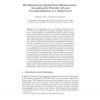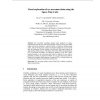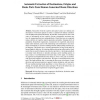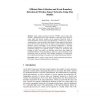118
click to vote
GISCIENCE
2010
Springer
15 years 12 days ago
2010
Springer
Wireless sensor networks are deployed to monitor dynamic geographic phenomena, or objects, over space and time. This paper presents a new spatiotemporal data model for dynamic area...
109
click to vote
GISCIENCE
2010
Springer
15 years 12 days ago
2010
Springer
We designed and implemented a simple and fast heuristic for placing multiple labels along edges of a planar network. As a testbed, realworld data from Google Transit is taken: our ...
141
click to vote
GISCIENCE
2010
Springer
15 years 12 days ago
2010
Springer
The categorization of our environment into feature types is an essential prerequisite for cartography, geographic information retrieval, routing applications, spatial decision supp...
GISCIENCE
2010
Springer
15 years 1 months ago
2010
Springer
Over the past decade, automated systems dedicated to geopositioning have been the object of considerable development. Despite the success of these systems for many applications, th...
171
Voted
GISCIENCE
2010
Springer
15 years 1 months ago
2010
Springer
Abstract. Eye movement recordings produce large quantities of spatiotemporal data, and are more and more frequently used as an aid to gain further insight into human thinking in us...
100
click to vote
GISCIENCE
2010
Springer
15 years 1 months ago
2010
Springer
As an alternative to expensive road surveys, we are working toward a method to infer the road network from GPS data logged from regular vehicles. One of the most important componen...
112
click to vote
GISCIENCE
2010
Springer
15 years 1 months ago
2010
Springer
Behavioral experiments addressing the conceptualization of geographic events are few and far between. Our research seeks to address this deficiency by developing an experimental fr...
109
click to vote
GISCIENCE
2010
Springer
15 years 1 months ago
2010
Springer
Researchers from the cognitive and spatial sciences are studying text descriptions of movement patterns in order to examine how humans communicate and understand spatial informatio...
137
click to vote
GISCIENCE
2010
Springer
15 years 1 months ago
2010
Springer
Semantic similarity measurement is a key methodology in various domains ranging from cognitive science to geographic information retrieval on the Web. Meaningful notions of similar...
126
Voted
GISCIENCE
2010
Springer
2010
Springer
Efficient Data Collection and Event Boundary Detection in Wireless Sensor Networks Using Tiny Models
15 years 1 months ago
Using wireless geosensor networks (WGSN), sensor nodes often monitor a phenomenon that is both continuous in time and space. However, sensor nodes take discrete samples, and an ana...




